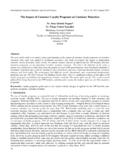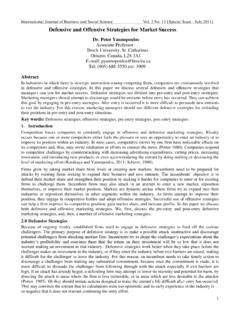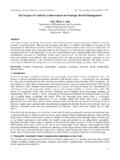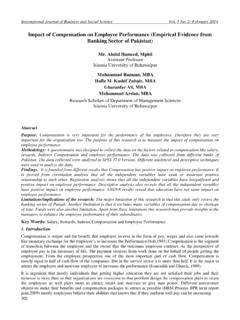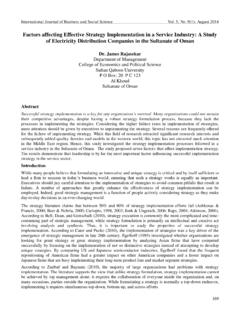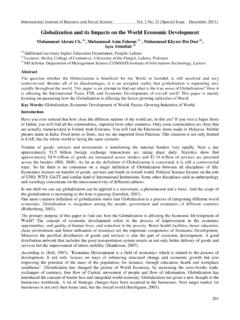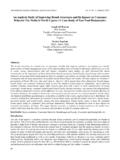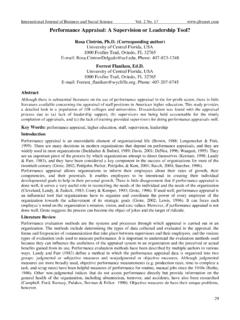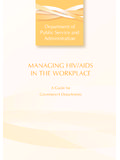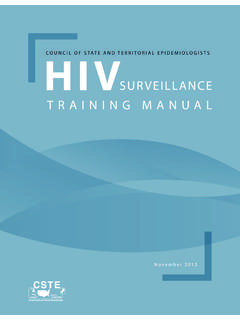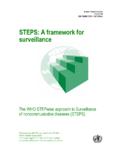Transcription of Assessment of Causes of Labour Turnover in Three …
1 International Journal of Business and Social Science Vol. 3 No. 15; August 2012 311 Assessment of Causes of Labour Turnover in Three and Five Star-Rated Hotels in Kenya Samson Kuria Karatina University College Kenya Dr. Ondigi Alice Prof. Peter Mwangi Wanderi Kenyatta University Kenya Abstract Studies done regarding Labour Turnover in the service industry across the world indicate that, the hospitality sector leads with many employees changing jobs from time to time. Subsequently, some Causes of Labour Turnover are believed to be industry-specific. Both the internal and external Causes of Labour Turnover affect the growth, profitability and customer satisfaction whenever it occurs in the workplace.
2 Employers see the process of staff leaving and being replaced as a natural and inevitable feature of the industry. In Kenya, very little has been documented on the Causes of Labour Turnover . This paper is based on a study completed in April 2011. The main purpose of this study was therefore to establish the internal and external Causes of Labour Turnover in Three and five star-rated hotels in Nairobi city. Nairobi city has seven hotels which are classified as five star and nine hotels which are classified as Three star hotels. The study adopted descriptive survey research design. This study involved a total of 133 permanently employed staff working in these star-rated hotels. Simple random sampling method was used to pick hotels as well as the respondents for this study.
3 The Employee Attitude Survey revealed that, lack of balance between work and personal life was a major cause of job resignation (32%) while lack of staff involvement in decision making and creativity was (56%) respectively in both set of hotels. Consequently, employees were familiar with job requirements and departmental mission statements. The need to create conducive work environment probably prompted them to ask for flexi- hours. Poor remunerations were cited with over 60% of the respondents dissatisfied. More so, was the undefined rewarding system where 46% of the respondents strongly disagreed. The study therefore recommended that, the management should improve the working condition for the employees as well as establishing training policies that equip employees with job requirements and expectations.
4 Finally, the need to establish a rewarding system that would motivate workers other than monetary remunerations is also recommended. Keywords: Star-rated hotels, Employee Attitude Survey, Flexi-hours. Background Information Labour Turnover is significant to organization, individuals and management. From the organizational perspective, Labour Turnover represents a significant direct cost in terms of recruiting, poor production practices and reduced standards as well as high replacement and training costs (Hiemstra, 1990). Subsequently, Fair (1992) suggests that, there are other costs associated with Labour Turnover which include separation costs (exit interviews and severance pay), recruitment costs (advertising and search fees), selection costs (interview and reference checking), hiring costs (induction and initial training), relocation expenses, uniforms and lost productivity costs associated with both the unfilled vacancy and the learning curve associated with the new employee.
5 Indirect costs however are associated with decreased levels of employee motivation, absenteeism, tardiness leading to customer dissatisfaction and ultimately customer defection (Fair, 1992). In his research on Labour Turnover , Price (1977) noted that, low Turnover rates present special challenges. The first is to resist over investing in prevention programs. Centre for Promoting Ideas, USA 312 While this may seem like unnecessary advice, some organizations spend large amount of money developing new programs and projects as well as solving problems that do not necessarily exist. Another challenge is to consider using leading indicators to spot Turnover problems before they become serious issues.
6 As mentioned earlier by Fair (1992), intention to quit is an important leading indicator along with organizational commitment and job satisfaction data. These leading indicators can be crucial for early analysis and action before Turnover develops into a serious problem. With such information, management may then be in a position to consider changes and improvements to their personnel practices in order to reduce Labour Turnover Causes . The provision of a high quality working environment with a range of employee-valued benefits may also increase satisfaction levels and hence discourage Turnover behaviors (Mobley, 1977). A final challenge is the notion of complacency. While it is important to move to other critical issues in the organization, Turnover should always be monitored.
7 It is a leading indicator to ensure that retention is not becoming an issue. Complacency can cause serious problems in eroding the good progress that has been developed previously. Lastly, measuring and monitoring Turnover is essential to bringing the appropriate attention to the issue and taking constructive action. Understanding the employment climate is fundamental to developing and understanding of retention. Having acceptable targets; based on precise definitions of Turnover that are meaning to the organization, help to bring the process clearly into focus. These are aimed at bringing the proper resources and attention to this critical issue so that action is taken .The senior management team should moreover accept the responsibility for managing retention.
8 Causes of Labour Turnover in hospitality industry Companies today generally recognize the important contribution that their employees play in delivering the services. However, they also make every effort to drive down internal costs as part of the price commitment. Labour Turnover is seen as one area of cost which can be measured and benchmarked. It is seen as a significant factor when measuring organizational performance, which management can influence (White, 1995). Low Labour Turnover is seen as an asset in the competitive war. High Labour Turnover is seen as a problem to be managed (Bannister and Griffeth, 1986; Glebbeek and Bax, 2004). According to Hinkin and Tracey (2000) high employees Turnover rates in the hotel industry are not country specific; this is a worldwide epidemic.
9 Fortino and Ninemeier, (1996), indicate that the United States of America has a national annual Turnover rates that range from 154 percent to 240 percent. This compared unfavorably with the 12 percent annual Turnover rates for all businesses in USA by 2000 as reported by Bureau of Labor Statistics (USA). Subsequently, General Managers in USA were found to have been with their current employers for approximately eight years (Cornell HRA Quarterly, 1992). Labour Turnover is a gradual process. According to Mobley (1977), an employee starts by an evaluation of an existing job and the environment in the work is being done. It is believed that work environment plays a pivotal role on an employee s decision to continue working in an organization or to quit.
10 Job dissatisfaction follows in deciding to quit. The employee may however evaluate the utility of searching for the new job. The search for an alternative job takes place and employee evaluates all the jobs that are available for him or her. Comparison is further done with the present and the best alternative jobs that are found. A final decision is reached by either remaining in the current job or quitting as the last stage. However, there exist the independent variables upon which jobs are being evaluated. These include the pay package, company policies, rules and regulations, the Hertzberg hygiene factors, work monotony and burnouts. This study was based on the employee decision process model adapted from Mobley (1977) modified as shown on Figure The model (Mobley1977) represents a theoretical process of 10- stages that an employee goes through when either quitting or changing jobs.
